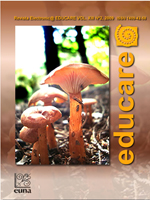Currículo en el nivel preescolar costarricense: El Ciclo Materno Infantil (CMI)
DOI:
https://doi.org/10.15359/ree.13-2.7Keywords:
curriculum, pre- school education, teachers, children, infantile maternal cycle, program of the infantile maternal cycleAbstract
The present article tackles the conceptualization and description of the Infantile Maternal Cycle as p The present article tackles the conceptualization and description of the Infantile Maternal Cycle as part of the preschool level of the Costa Rican educational system. With the intention of having a wider vision of this Cycle, a revision is done for the curriculum concept, as well as, for the elements that shape it, and then there is a detailed description of specific aspects related to the preschool Costa Rican curriculum of the Infantile Maternal Cycle, taking as a starting point the Program of Study that was designed to attend the above Cycle in the Costa Rican educational system.
References
Bolaños, G. & Molina, Z. (2001). Introducción al currículo. (2a. ed.). San José, Costa Rica: Editorial
de la Universidad Estatal a Distancia.
Castillejo, J. (1992). El currículo en la educación infantil. En E. Martínez (Ed). El currículo de la
educación preescolar. México, D.F.: Santillana.
Cerdas, A. & Mata, A. (2001). Implementación Programa de Estudio para el Ciclo Materno
Infantil. San José, Costa Rica: Ministerio de Educación Pública.
Costa Rica. Ministerio de Educación Pública. (2001). Programa de Estudio Ciclo Materno Infantil.
San José, Costa Rica: Autor.
Costa Rica. Ministerio de Educación Pública. (2002). Educación preescolar en Costa Rica.
Consideraciones y Lineamientos para el desarrollo de la práctica pedagógica en el nivel
preescolar. San José, Costa Rica: Autor.
Costa Rica. Ministerio de Educación Pública. (2008). Concepción Curricular. Programa de Estudio
Ciclo Materno Infantil. San José, Costa Rica: Autor.
Costa Rica. Ministerio de Educación Pública. (2009). Orientaciones Curriculares Nacionales. San
José, Costa Rica: Autor.
Chaves, A. (2004). Análisis de la congruencia entre el Programa de Estudio para el Ciclo Materno
Infantil, del Ministerio de Educación Pública y las características, intereses y necesidades
de los niños y las niñas de 4 años y medio a 5 años y medio, que asisten a los grupos interactivos
II de dos jardines infantiles públicos del área metropolitana. Tesis para optar por
el grado de Licenciatura en Pedagogía con énfasis en Educación Preescolar. Heredia, Costa
Rica: Universidad Nacional.
D’Angelo, E. y Medina, A. (1999). Elección de materiales desde un enfoque didáctico comunicativo.
En Materiales y recursos: La educación en los primeros años. (pp. 52-77). Buenos Aires,
Argentina: Ediciones Novedades Educativas.
Ford, A., Davern, L. & Schnorr, R. (1999). Educación inclusiva. “Dar sentido” al currículo. Aulas
Inclusivas. Madrid; España: Narcea de Ediciones.
Grundy, S. (1998). Producto o praxis del curriculum. (3ª ed). Madrid, España: Ediciones Morata.
Peralta, V. (2002). Una pedagogía de las oportunidades. Santiago, Chile: Editorial Andrés Bello.
Peralta, V. (2007). El currículo en el Jardín Infantil. Un análisis crítico. (1ª Reimp. de la 3ª ed.)
Santiago, Chile: Editorial Andrés Bello.
Pérez. R. (1994). El curriculum y sus componentes. Hacia un modelo integrador. Barcelona,
España: Oikos-Tau.
Posner, G. (1998). Análisis del currículo. (2ª ed.). Bogotá, Colombia: Mc Graw-Hill.
Quesada, M., Cedeño, M. & Zamora, J. (2001). El diseño curricular en los planes de estudio: aspectos
teóricos y guía metodológica. Heredia, Costa Rica: Editorial de la Universidad Nacional.
Downloads
Published
How to Cite
Issue
Section
License
1. In case the submitted paper is accepted for publication, the author(s) FREELY, COSTLESS, EXCLUSIVELY AND FOR AN INDEFINITE TERM transfer copyrights and patrimonial rights to Universidad Nacional (UNA, Costa Rica). For more details check the Originality Statement and Copyright Transfer Agreement
2. REUTILIZATION RIGHTS: UNA authorizes authors to use, for any purpose (among them selfarchiving or autoarchiving) and to publish in the Internet in any electronic site, the paper´'s final version, both approved and published (post print), as long as it is done with a non commercial purpose, does not generate derivates without previous consentment and recognizes both publisher's name and authorship.
3. The submission and possible publication of the paper in the Educare Electronic Journal is ruled by the Journal’s editorial policies, the institutional rules of Universidad Nacional and the laws of the Republic of Costa Rica. Additionally, any possible difference of opinion or future dispute shall be settled in accordance with the mechanisms of Alternative Dispute Resolution and the Costa Rican Jurisdiction.
4. In all cases, it is understood that the opinions issued are those of the authors and do not necessarily reflect the position and opinion of Educare, CIDE or Universidad Nacional, Costa Rica. It is also understood that, in the exercise of academic freedom, the authors have carried out a rogorous scientific-academic process of research, reflection and argumentation thar lays within the thematic scope of interest of the Journal.
5. The papers published by Educare Electronic Journal use a Creative Commons License:














 The articles published by Educare Electronic Journal can be shared with a Creative Commons License:
The articles published by Educare Electronic Journal can be shared with a Creative Commons License: 



